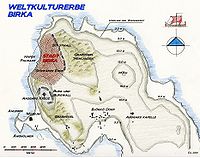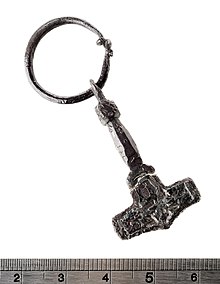Birka
"Birch Island") in present-day Sweden, was an important Viking Age trading center which handled goods from Scandinavia as well as many parts of Continental Europe and the Orient.Birka was the Baltic link in the Dnieper Trade Route through Ladoga (Aldeigja) and Novgorod (Holmsgard) to the Byzantine Empire and the Abbasid Caliphate.As a trading center, Birka most likely offered furs, iron goods, and craft products, in exchange for various materials from much of Europe and Western Asia.(Chapter IX)Ansgar then undertook the mission committed to him by the emperor, who desired that he should go to the Swedes and discover whether this people was prepared to accept the faith as their messengers had declared.The merchants with whom they were travelling, defended themselves vigorously and for a time successfully, but eventually they were conquered and overcome by the pirates, who took from them their ships and all that they possessed, whilst they themselves barely escaped on.—With great difficulty they accomplished their long journey on foot, traversing also the intervening seas (maria), where it was possible, by ship, and eventually arrived at the Swedish port called Birka.None of them is however said to have had his residence there, as the Swedish king and his retinue periodically moved between the Husbys, parts of the network of royal estates called Uppsala öd.(Chapter XI)Herigar's church was not far from the place where tings were held: On one occasion he himself was sitting in an assembly of people, a stage having been arranged for a council on an open plain.—The king then rose up from amongst the assembly and forthwith directed one of his own messengers to accompany the bishop's messenger, and to tell him that the people were unanimously inclined to accept his proposal and at the same time to tell him that, whilst their action was entirely agreeable to him, he could not give his full consent until, in another assembly, which was to be held in another part of his kingdom, he could announce this resolution to the people who lived in that district.In Gesta Hammaburgensis ecclesiae pontificum (Deeds of Bishops of the Hamburg Church),[13] Adam of Bremen mentions Birka many times, and the book is the main source of information on the city.On this anchorage, being the best sheltered within the maritime region of Sweden (Suevoniae), all the ships belonging to Danes (Danorum) known as Norwegians (Nortmannorum) as well as to Slavs (Sclavorum), Sembrians (Semborum) and other Scythian (Scithiae) peoples use to convene every year for sundry necessary commerce.(I 62)Turning from the northern parts to the mouth of the Baltic Sea we first meet the Norwegians (Nortmanni), then the Danish region of Skåne (Sconia) stands out, and beyond these live the Geats (Gothi) for a long stretch all the way to Birka.[15] But by land from Skåne across the Geatish people (Gothorum populos) and cities Skara (Scaranem), Telgas and Birka, one reaches Sigtuna only after a full month.(IV 20)Since it is physically impossible for any Swedish town to face Jumne, the latter being situated along River Oder, Adam's statement is probably a misunderstanding.(IV 20)John seems to have been situated in Birka in order to prepare for the missionary work among the many heathen people that flooded to Birca from around the Baltic coasts.Noteworthy here is that the biggest islands in the Baltic Sea, Öland and Gotland, were part of the diocese of Linköping in the Middle Ages, covering also Östergötland and eastern Småland.Talking about Adalvard the Younger, the bishop of Sigtuna and later that of Skara, Adam or a later copyist has written: During his journey he seized the opportunity to make a detour to Birka, which is now reduced to loneliness so that one can hardly find vestiges of the city; therefore impossible to come upon the tomb of the holy Archbishop Unni.In the late 19th century, Hjalmar Stolpe, an entomologist by education, arrived on Björkö to study fossilized insects found in amber on the island.Mostly made from wool and flax, the quality of the textiles studied by Geijer ranged from very coarse to fine fabrics with high thread counts that required complicated techniques to create.On 15 June 2022, it was announced that archaeologists from Stockholm University's Archaeological Research Laboratory had found a Viking Age shipyard in Lake Mälaren."The site found consisted of a stone-lined depression in the Viking Age shore zone with a wooden boat slip at the bottom.The finds at the site consist of large quantities of both unused and used boat rivets, whetstones made from slate and woodworking tools.[28] Stephennie Mulder, a professor of Islamic art at the University of Texas at Austin, replied to Larsson's findings in a Twitter thread.The surrounding fragments of textiles attached to these brooches, scattered around various graves across Sweden, also give an understanding of what the typical womenswear of the Viking age may have been in the 9th and 10th centuries.[40] Dirham coins have been located all around Scandinavian countries and suggest strong trade relations existed between the medieval Middle East and Northern Europe.[44] Many graves contain objects such as coins, glass, and textiles that originated in foreign countries as far as the Middle East and Eastern Asia.[39][46] Scholar Marianne Hem Eriksen maintains that this girl is an unusual case of a high-status child burial, as children were seldom buried with identifiable grave goods.











Birka (disambiguation)BirkariaEkerö MunicipalitySwedenViking AgeUNESCO World Heritage SiteHovgårdensessionEurope and North AmericaBjörköScandinaviaContinental EuropeLake MälarenStockholmEkeröSigtunaChristianAdelsötrading networksinfluenceUNESCOWorld Heritage SiteSuecia antiqua et hodiernaBalticDnieper Trade RouteLadogaNovgorodByzantine EmpireAbbasid CaliphateSaint AnsgarmartenbeaverwalrusRhinelandtextilesChinese silkembroiderybrocadespassementerieHaithabudirhamsCarolingianVita AnsgariRimbertAnsgarGesta Hammaburgensis Ecclesiae PontificumAdam of BremenArchbishopthe Norse religionLatinisedOld NorsebjärköarättDenmarkNorwayMälarenGotlandRus'-Byzantine tradeVarangianRussiaarchbishop of Hamburg-BremenLouis the PiousHamburgBremenScaniaBjörnHusbysUppsala ödAnund UppsaleTing of all SwedesUppsalaDistinglawspeakerTiundalandTing of all GeatsLionga tingLinköpingAdalvard the YoungerGeatishoppidumtemple called UppsalastadionsSembriansScythianSkåneVästergötlandÖstergötlandEstlandterrae feminarumSödertäljeRiver OderArchbishopric of Hamburg-BremenAdalvard the ElderSami peopleÖlanddiocese of LinköpingSmålandChronicle of SwedenJohan HadorphHjalmar StolpeentomologistAgnes Geijertablet woven textileshectareshill fortdark earthUppsala UniversityUniversity of Texas at AustinselvagessilverSwedish history museumpseudo-Kuficاللهtin alloysoapstonedress pinsMjöllnircrossesThor's hammerbroochDirhamcaliphTashkentUzbekistanBirka female Viking warriorcremationsinhumations